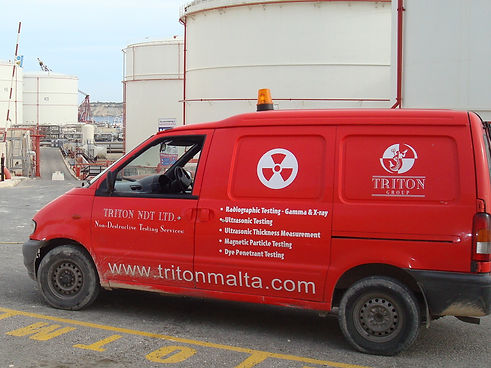Non Destructive Testing (NDT)
Triton NDT boasts the capacity to meticulously carry out Non Destructive Testing (NDT) for all kinds of metals. NDT is popular and highly valuable because it does not harm the material being inspected, meaning you can save time and money in product evaluation, troubleshooting and research. A wide variety of companies have benefited from Triton NDT’s services, mainly in the shipping, petrochemical and engineering sector. The various forms of NDT testing we offer include MPI (Magnetic Particle Inspection), DPI (Dye Penetrant Inspection), UT (Ultrasonic Testing), and RT (Radiography). Triton NDT is the leader in the provision of such services in Malta, and our inspection personnel are highly qualified and certified in accordance with the British Institute of Non-Destructive Testing – PCN Certification.
UT
(Ultrasonic Testing)
This kind of testing is commonly used to conduct examinations and make measurements. UT can be used to detect imperfections or changes in materials as well as to determine thicknesses of objects and to monitor pipework corrosion. UT is a very useful and versatile NDT method. Some of the advantages of this form of inspection include its sensitivity to both surface and subsurface flaws making it a highly accurate method. In addition, the depth of penetration or measurement is superior to all other NDT methods as detailed images can be produced with automated systems.


Dye Penetrant Inspection (DPI)
DPI is one of the most popular forms of NDT because it is a low-cost inspection method and can be used to locate defects in all non-porous materials - metals, plastics or ceramics. This process is also called Liquid Penetrant Inspection (LPI) or Penetrant Testing (PT) and is used to detect casting, forging and welding surface defects like cracks, surface porosities, leaks in new products and fatigue cracks on in-service components.
Magnetic Particle Inspection (MPI)
MPI is a widely-used NDT process that induces a magnetic field in ferroelectric materials (like iron, nickel, cobalt and some of their alloys) to allow the identification of cracks at the surface or just below, as well as discontinuities in items such as weldment and powdered metal products. We can calculate what the imperfection is, what could have caused it, and what action can be taken.


Radiography (RT)
Radiography involves the use of X-rays to examine parts and products for imperfections. Triton NDT methodology directs radiation through a specific part and onto a film in order to locate any imperfections.
Heritage Radiography (RT)
Radiography use of X-rays are capable not only examine structural defects, Also we can use for Restoring Paints and its hidden secrets.
For Statues- Identifying undying structures.


Hardness Testing
Hardness testing is a non-destructive test method for measuring the resistance of a material to deformation, specifically to the indentation or scratching of its surface. It is a non-destructive method that involves applying a controlled load, typically in the form of a rounded or pointed object, onto the surface of the material to create an indentation or impression.
Crack Depth Monitoring
Deciding whether to repair, monitor, or scrap a component with a crack often depends on the crack's depth and application-specific factors such as part replacement costs and lead times. We have solution in measuring crack depth compared to any other non-destructive testing (NDT) technique.


Radiation Expertise & Advisory
We offer a range of services related to radiation safety, including conducting risk assessments, developing local rules, providing on-site monitoring for radioactive contamination, offering basic radiation safety awareness courses, managing disused radioactive sources, and providing radioactive-free certification. The goal of a Radiation Expert/Advisor is to ensure that organizations and individuals are knowledgeable about radiation safety principles and practices, and to help them minimize risks associated with radiation exposure.
